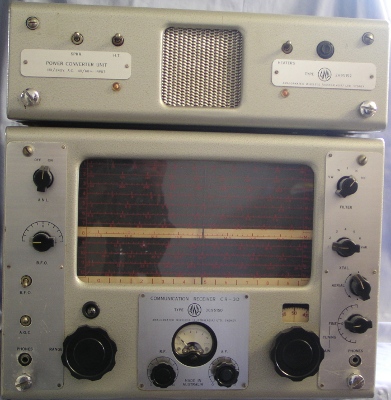
AWA CR-3D "ARGOSY" 3C95150
Click to view circuit in a new window Part-1, Part-2, Part-3 Part-4.
Click to view detailed illustrations of the receiver.
General Description
-
-
The CR-3D was manufactured by AWA in 1957. It is an AM/CW communications receiver that was used on ships and land stations. The "Argosy" name was used in AWA ship installations and the CR-3D ident was used in land applications. The Overseas Telecommunications Commission (Australia) used these receivers in marine operations. There appear to be minor variations in design depending on the various users requirements.
Technical Details
-
-
The set is a 14+2 valve superhet covering the range 14kHz to 30.1mHz in twelve bands. It features variable selectivity and fine tuning. It is also capable of high fidelity output.
The receiver includes a test lead which can be moved between internal sockets, to monitor readings on the front panel meter.
A monitoring loudspeaker is built into either of two power supplies, one working from 120/240v mains and the other from 24v DC.
The all up weight of the receiver with mains power supply is 100lbs.
| The valve complement is: | |
| 6BA6 1st RF | 6BA6 2nd IF | ECH81 2nd Mixer/Osc |
| 6BA6 2nd RF | 6AU6 3rd IF | ECH81 BFO/Buffer Amp |
| ECH81 1st Mixer/Osc | 6AL5 Det/AN | 6AU6 AGC Amp |
| 6AM6 Xtal Osc | 6AU6 1st AF Amp | 6AL5 AGC Rectifier |
| 6BA6 1st IF | 6C4 2nd AF Amp | |
The mains power supply contains 5Y3 Rectifier and OC3/VR105 voltage regulator.
The IF frequencies are as follows – 85kHz on bands 2 and 3 (100-630kHz). On the remaining bands the receiver is double conversion, with a first IF of 585kHz and a 2nd IF of 85 kHz.
There is provision for 6 xtal locked channels, using D style holders - 30pf shunt capacitance, at 0-60 degrees C (Xtal Freq = Signal Freq + 585kHz with fundamental xtals).
Sensitivity figures are quoted at 14-50kHz 30uv, 50-110kHz 10uv, 110-240 kHz 5uv, 240kHz-4.0mHz 3uv, 4.0-30.1mHz 1uv, all at 3db s/n.
While being relatively old the receiver would be capable of excellent performance on AM and CW. In its existing form it is not provided with a product detector for SSB reception.
Detailed illustrations of the receiver are shown on a separate page.
Back to Top
Back to Top or
Go to Home page.
© Ian O'Toole, 2011.
Page created: 4/09/11 Last updated: 27/10/2012
